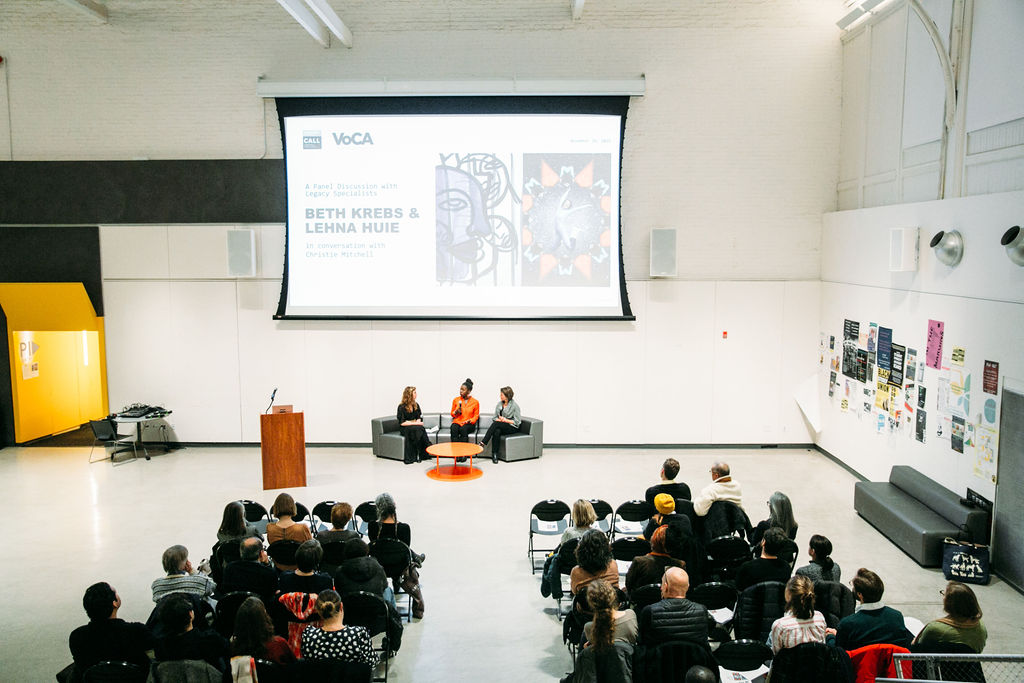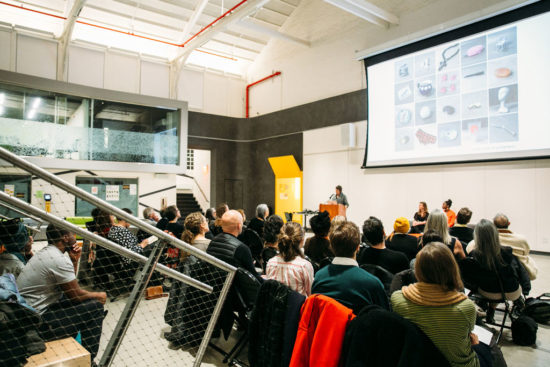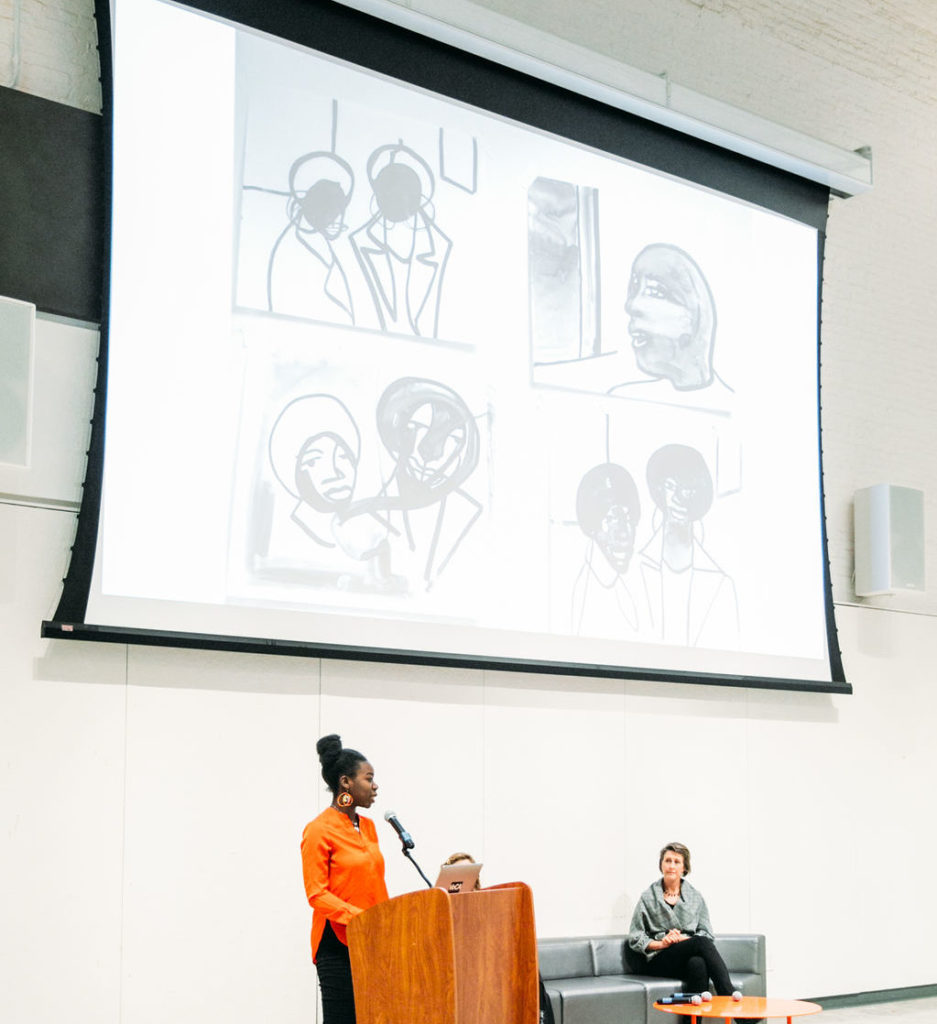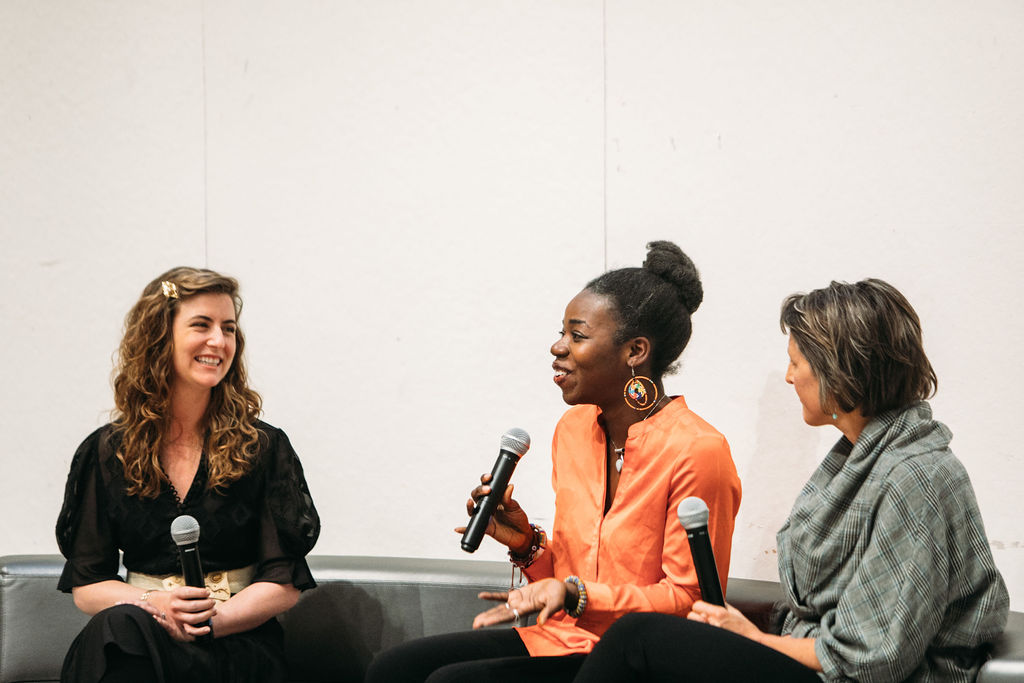This week’s contributing author, Allison Spangler, is a Master of Arts student in the Museum Studies Program at New York University. Her current research involves museum programs that center around the inclusion of the living artist’s voice as an integral component to collection stewardship, documentation, and archiving.

The discussion that unfolded on December 6, 2019 at Pratt Institute as part of the CALL/VoCA Talk series is the perfect embodiment of why programs of this kind are so beneficial to the arts. The evening was designed so that Artists and Legacy Specialists, Beth Krebs and Lehna Huie, could introduce their own practices and reconvene for a panel discussion, moderated by Christie Mitchell, Senior Curatorial Assistant at the Whitney Museum of American Art. Following the structure of the CALL program, Krebs and Huie were trained by the Joan Mitchell Foundation as Legacy Specialists who were paired with “mature artists,” and tasked to collaborate with these artists to establish their archives.[1] Krebs (paired with Artists John Koos and Arlun Huang) and Huie (paired with Artist Marcos Dimas) discussed the impact of the CALL program, namely how this artist mentorship and artist-to-artist sharing can have mutual impact on future artwork creation and art-making practices.

Beth Krebs and Lehna Huie were excellent counterparts in this discussion. Interviews influence Krebs’ videos and Huie’s paintings, so although the artists create drastically different work, they both engage with their subject matter primarily through narratives and social practices. Krebs and Christie Mitchell even joked that conducting interviews for the sake of her art provides Krebs with the necessary formality because she can be “shy but nosy.” Krebs’ ongoing installation work, Lost Luck, depicts replicas or “surrogates” of lucky objects that interview subjects once owned.[2] Similarly, Huie values legacy, lost stories, and family archives. Her documentary film, To Move Mountains (to be released in 2020), details the lives and works of three female U.S. cultural organizers.[3] Krebs and Huie’s experience in creating artworks that are interview-based allows them to realize the necessity of including their CALL artists’ voices as a component of their legacies.

To commence the panel discussion, Christie Mitchell prompted Krebs and Huie to discuss active decision-making during the CALL project, noting the subjectivity involved in building an archive. Both Legacy Specialists highlighted the need for a systematic approach to begin the process, goal-setting with their CALL artist and quarterly reviews in order to keep everyone on track. The emotional nature of creating an archive was discussed; art as a connector and the relationships that form when given the time and capacity to reflect on practice and ethos. Huie’s face lit up in telling about the political exchanges she and CALL artist Marcos Dimas have had and addressed the crucial aspect of trust-building needed for projects of this nature to occur. Krebs spoke of Huang as a valuable resource; the two were able to mutually relate to the highs and lows that accompany artists’ careers. The multi-faceted benefits of CALL were evident from the evening’s discussion. Mentorship, information-exchange and artist archives were produced and, in turn, both artists were encouraged to reflect on their own practices. Projects like the Joan Mitchell Foundation’s CALL initiative and organizations like VoCA prioritize the inclusion of the living artists’ voice as an important component to their legacies, while supporting the on-going development of critically aware arts practitioners.

The goal of the CALL/VoCA collaboration is succinctly stated in an interview with Shervone Neckles-Ortiz, Artist Programs Manager at the Joan Mitchell Foundation: “…it’s a stewardship not just of the [art]work itself, but of all that encompasses the artist’s life when they are existing and making work.”[4] Comprehensive, multi-authored artwork records of this nature not only provide valuable insight into artist working practice, but also as to object care, and can be highly influential in future artwork activation. With the complex nature of contemporary art today, institutions are looking to combine deep collections research in tandem with artist, scholar, and specialist insight in order to best care for their collections and archives. Pioneering projects such as The Artist Initiative (The San Francisco Museum of Modern Art), Reshaping the Collectible: When Artworks Live in the Museum (The Tate Modern), and The Artist Archives Initiative (New York University), are comparable to CALL and VoCA in that all are devoted to optimized collections care through collaborative research and consultation with the living artist. It is evident that relationship-based, comprehensive collections care of this kind will only continue within institutions. CALL and VoCA are providing capacity and training, while promoting the necessity for this kind of activity to continue in future.
[1] The Joan Mitchell Foundation. “Creating a Living Legacy (CALL).” Accessed December 7, 2019. https://joanmitchellfoundation.org/artist-programs/call.
[2] Beth Krebs. “Beth Krebs.” Artist website. Accessed December 9, 2019. https://www.bethkrebs.com/
[3] Lehna Huie. “To Move Mountains. About the Film.” Artist website. Accessed December 9, 2019. https://www.tomovemountainsfilm.com/
[4] Voices in Contemporary Art. “Preserving the Artist’s Voice: Looking Back on Five Years of CALL/VoCA Talks.” Accessed November 26, 2019. https://voca.network/blog/2019/11/08/preserving-the-artists-voice-looking-back- on-five-years-of-call-voca-talks/.
